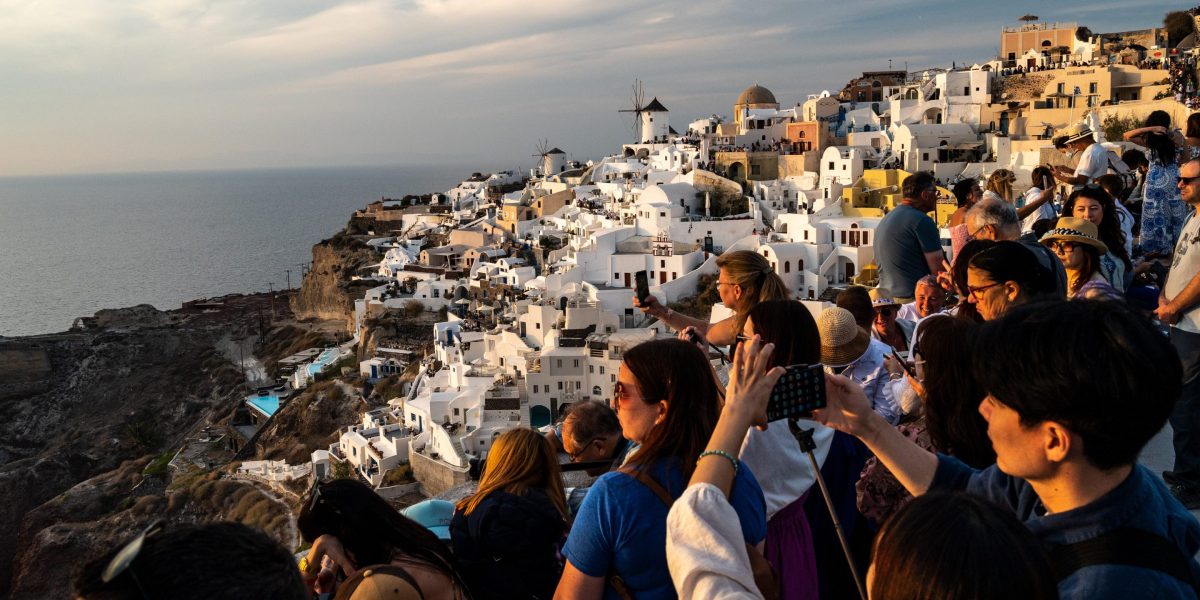

Santorini’s whitewashed streets will heave with millions of visitors this summer. Not everyone on the Greek island will be happy to see them.
“Tourism destroys the vineyards,” wine producer Matthew Argyros said in an interview. “I raise a red flag for the island.” His family winery, set up in 1903, produces from about a quarter of the island’s vineyards, and he warns that agricultural land prices have rocketed in the area as developers clamor for space to build more holiday lets.
Production of Santorini grapes has dropped almost 50% in the last 20 years, with an average 2.7% drop per year, according to data collected by the Association of Winemakers of Santorini. The production, according to the island’s winemakers, is in danger of dropping to zero by 2041 if there’s no intervention of some form. Water shortages are making it harder to grow the vines, while they’ve lost most of their workers to the tourism industry through the years, Argyros said.
From her balcony in the hilltop village of Pyrgos, Antonia Noussia could once see grapes growing all the way to the coast. Now, she says, there are “only small patches of vineyards left.”
“You can see people carrying sheets, breakfast supplies, and it doesn’t feel like an inhabited village,” said Noussia, an associate professor of urban design and planning at London South Bank University, who lives half the year on the island where she spent all her summers growing up. When the tourists disappear over winter, locals rely on a single small grocery shop.
Tourism has accelerated throughout Europe since the pandemic, worsening supply problems, traffic-choked streets and economic imbalances in several hotspots such as Santorini. Some places are attempting to ease the pressure with visitor fees, caps and even temporary bans — with limited signs of success, as a record-breaking summer gets underway.
“It’s going to be a very bad year for Santorini,” according to Mayor Nikos Zorzos. The island can afford “not one single bed more” for accommodation, he added — stressing that this would still be the case even if infrastructure is improved to help the island cope with higher numbers. The municipality is unable to impose a construction ban, so he wants the Athens government to act.
Santorini is expecting 3.4 million tourists this summer, despite local authorities asking for limits since 2012, Zorzos said.
Greek Prime Minister Kyriakos Mitsotakis has acknowledged the area faces a problem of “over-tourism.” In June, he announced plans to restrict cruise ships for the country’s most popular islands. “I think we’ll do it next year,” Mitsotakis said in an interview at the time.
The new rules could see the total number of island berths restricted, or a bidding process introduced for slots. It’s the latest proposal to limit day-trippers from cruise ships.
Zorzos previously set up a cap of 8,000 cruise visitors per day, though this was annulled during the pandemic and recently reinstated, so the overall effect on tourist numbers is unclear. Santorini’s local authorities have also managed to bring down the number of days each cruise ship can visit the islands to 48 days from 63 for this season — a number that’s set to drop even further next year.
Greece’s central administration is also seeking to impose restrictions on short-term leasing in congested areas, including most of its top destinations in the Aegean and the Ionian islands. The government has drafted a bill, which is currently under public consultation, which links the amount of short term rentals to the number of available hotels in each region.
The European Commission has recognized the problems on the islands, saying in a 2018 report that visitors brought €1 billion ($1.1 billion) a year to Santorini while swelling the population to as many as 107.8 tourists for every 100 inhabitants. Some of the negative impacts “have permanent consequences on the island and its community,” the report’s authors wrote.
Summer Protests
It’s a sentiment shared by other communities living among Europe’s star attractions. Venice has this year introduced an entrance fee and banned large and loud groups from entering. In the Spanish destinations of Mallorca and the Canary Islands, locals have been protesting to reclaim space from visitors. Barcelona has also become a focal point of anger over tourism squeezing out residents.
Some have taken emergency measures after local infrastructure buckled under pressure. In late June, the mayor of the Italian island of Capri announced a ban on incoming tourists due to a severe water shortage — though the measure was relaxed within a day once supplies were fixed, according to local media.
“The problem is not just limited to a few islands and it’s definitely not just Greek,” said Ioannis Spilanis, assistant professor of the University of the Aegean. “The problem has been more than obvious since at least 2018, then the pandemic came and we forgot about it and rushed to bring travel and tourism back to make up for the damage.”
During the summer of 2023, Greeks reclaimed beaches from sunbeds and beach bars, a protest known as the “towel movement.” The government adopted stricter rules on the use of beaches and has made sure they are being implemented with frequent inspections. In Greece, all beaches are by law free to access and cannot be private.
The stakes are high for the Greek economy. After more than a decade of austerity following the financial crisis, GDP remains much lower than it was before 2008. Tourism has been a bright spot, breaking pre-pandemic records and representing almost one fifth of economic output in 2023, according to the World Travel and Tourism Council.
The country attracted 32.7 million tourists in 2023, 18% more than the year before, according to the Bank of Greece, while the first quarter of 2024 has brought nearly 25% more visitors than the same period last year.
Endangered Sites
Meanwhile, the pressure continues to build in some places. A few islands away from Santorini on beach hotspot Serifos, mayor Konstantinos Revinthis said there are no restaurants open from December to February. “Nothing is for the locals in Serifos anymore,” he said.
Serifos, along with Folegandros and Sifnos, this year made it to the list of Europe’s most endangered sites compiled by heritage group Europa Nostra, which pointed to “rampant construction” and the degradation of natural resources. Wildfires have been breaking out in July as Greece’s heat wave smolders.
Revinthis said “tourists are set for a bad surprise this year due to water shortage,” and should also brace for worsening traffic jams that might cause them to miss their ferry departure time. “They must know that they will not be able to shower, if there’s no immediate solution.”















